Motor control apparatus
a technology of motor control and control apparatus, which is applied in the direction of motor/generator/converter stopper, dynamo-electric converter control, instruments, etc., can solve the problems of preventing the generation of torque that drives the rotor in the reverse rotation direction, and reducing the time taken to return the rotation direction from the reverse direction to the normal direction
- Summary
- Abstract
- Description
- Claims
- Application Information
AI Technical Summary
Benefits of technology
Problems solved by technology
Method used
Image
Examples
first embodiment
[0081] A first embodiment in which the present invention is applied to apposition switching device of a vehicle will be hereinafter described with reference to FIGS. 1-48.
[0082] First, the configuration of a position switching mechanism 11 will be described with reference to FIG. 1. A motor 12 as a drive source of the position switching mechanism 11 is a switched reluctance motor, for example, incorporates a speed-reducing mechanism 26 (see FIG. 4), and is equipped with an output shaft sensor 14 for detecting a rotation position of the output shaft 13 of the speed-reducing mechanism 26. A detent lever 15 is fixed to the output shaft 13.
[0083] An L-shaped parking rod 18 is fixed to the detent lever 15. A conical body 19 that is provided at the tip of the parking rod 18 is in contact with a lock lever 21. The lock lever 21 is moved in the vertical direction in accordance with the position of the conical body 19 and thereby locks or unlocks a parking gear 20. The parking gear 20 is a...
second embodiment
[0386] In the above first embodiment, with attention paid to the fact that the output shaft sensor 14 for detecting a rotation position of the output shaft 13 of the SR motor 12 (i.e., an actual shift position) is provided, an actual shift position that is detected by the output shaft sensor 14 at starting (e.g., after resetting of the CPU of the ECU 41 or after power application to it) is set as an instructed shift position sft of starting. Where the output shaft sensor 14 is not provided, it is appropriate to set an instructed shift position sft of starting as in a second embodiment of the invention shown in FIGS. 49 and 50. It goes without saying that the instructed shift position setting method according to the second embodiment may be applied to a system that is provided with the output shaft sensor 14.
[0387] In the second embodiment, a latest instructed shift position sft is stored in the nonvolatile memory such as an SRAM of the ECU 41 while the vehicle is driven. At startin...
third embodiment
[0401] During rotation of the SR motor 12, as shown in FIG. 52, the encoder 46 outputs an A-phase signal pulse and a B-phase signal pulse alternately in synchronism with the rotation of the rotor 32 and also outputs a Z-phase signal pulse every time current supply is effected for all the phases around and the rotor 32 is rotated by 45°. Since reference rotation positions of the rotor 32 can be detected correctly by using the Z-phase signal, whether the corresponding relationship between the rotation position of the rotor 32 and the current supply phase (i.e., encoder count) is not deviated from a correct one can be checked by determining whether a current supply phase (i.e., encoder count) with which a Z-phase signal pulse is output corresponds to a reference rotation position of the rotor 32. A highly reliable motor control can be performed by performing, if a deviation from the correct relationship is found, a Z-phase correction for correcting for the deviation.
[0402] The Z-phase...
PUM
 Login to View More
Login to View More Abstract
Description
Claims
Application Information
 Login to View More
Login to View More - R&D
- Intellectual Property
- Life Sciences
- Materials
- Tech Scout
- Unparalleled Data Quality
- Higher Quality Content
- 60% Fewer Hallucinations
Browse by: Latest US Patents, China's latest patents, Technical Efficacy Thesaurus, Application Domain, Technology Topic, Popular Technical Reports.
© 2025 PatSnap. All rights reserved.Legal|Privacy policy|Modern Slavery Act Transparency Statement|Sitemap|About US| Contact US: help@patsnap.com



